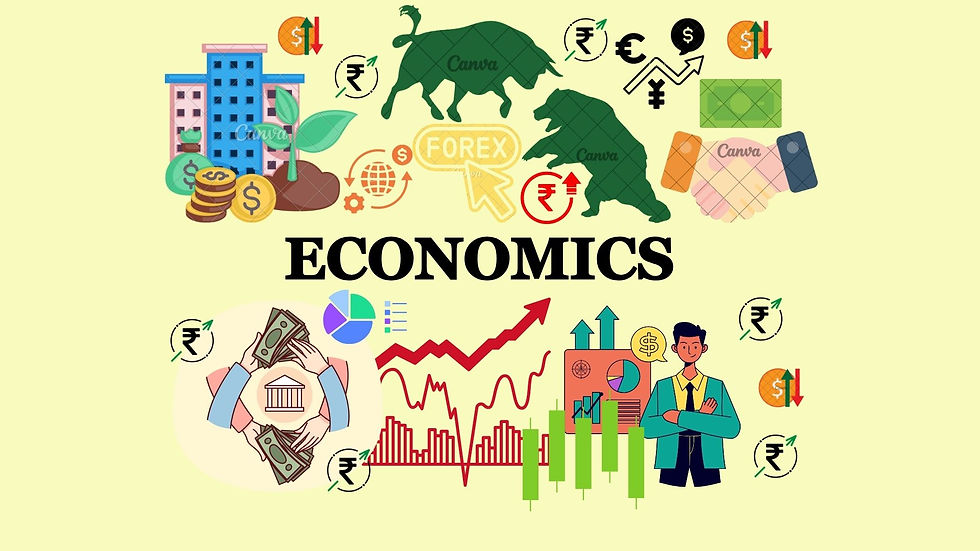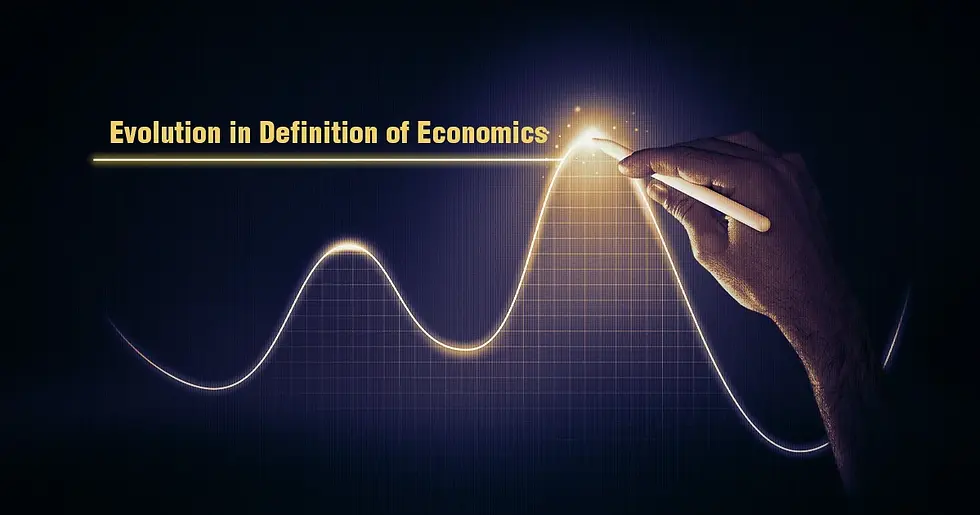📊 WBCS Optional Economics: The Optional That’s Not So Optional Anymore:
- iamkoustav28112k
- Aug 6
- 11 min read

So, you’ve made the brave decision to appear for WBCS (West Bengal Civil Services) — congratulations, you’ve officially entered the land of notes, nerves, and non-stop revisions.
Now comes the twist in the tale: choosing your Optional Subject — arguably the most make-or-break decision in the entire Mains exam. And there you are, scrolling through the list of subjects like it’s a confusing restaurant menu. “Should I go for something spicy like Political Science? Or something mild like Sociology? Will History repeat itself (pun intended)?” And somewhere in the middle sits Economics — the underrated, power-packed, protein-rich option that too many overlook.
Let us cut the confusion.
Economics Optional is not just a subject — it’s a strategic weapon. Why? Because it’s logical, analytical, and overlaps beautifully with General Studies. It’s not about rote memorization of treaties or ancient kings — it’s about understanding the world around you, interpreting data, decoding policies, and thinking like a policymaker. From India’s budget announcements to inflation rates and global economic shifts — it’s all part of the syllabus and part of real life.
In short: if you enjoy patterns, policies, and making sense of chaos, Economics could be your Optional soulmate.
Also — here’s a fun fact that no one tells you: it has a smaller competition pool. Not many candidates opt for Economics (yet), which means if you’re well-prepared, your chances of standing out skyrocket. And trust us — the WBCS board loves well-written, diagram-supported, data-rich Economics answers.
So if you're hunting for an optional subject that’s nutritious for your brain, rich in marks, and easy to digest with the right guidance — Economics is the one.
📚 What is WBCS Economics Optional?
If you’re serious about cracking the WBCS Mains, you already know this: the Optional Subject is no side character — it’s a lead role in your marksheet story. You choose one Optional, and it comes with two papers (Paper I & Paper II), each carrying 200 marks. That’s a total of 400 marks—a solid opportunity to skyrocket your rank if you play it smart.
Now, if you’ve zeroed in on Economics Optional, congrats! You’ve picked a subject that’s not just intellectually rich but also deeply connected with real-world policy, governance, and your everyday chai-time discussions.
So, What Exactly Do You Study?
Economics isn’t just about demand curves or equations—it’s about understanding why the economy behaves the way it does. Why does fuel price go up? What’s the big deal about inflation? Why does the dollar get stronger the moment you book your international tickets? You’ll learn all of this — and more — in this optional.
Let’s break it down 👇
🧠 Paper I – Theoretical Groundwork + Global Economics
This is where you build your foundation — a perfect blend of analytical, mathematical, and conceptual understanding.
🔹 Microeconomics
Think of it as the study of people, firms, and choices. You'll analyze supply-demand, consumer behavior, market structures, and yes — that mythical concept called perfect competition, which you’ll never actually see in real life.
🔹 Macroeconomics
Welcome to the world of GDP, unemployment, inflation, and fiscal deficits — all the things politicians love to brag or argue about. Understand how national economies function and why monetary policy gives RBI sleepless nights.
🔹 Statistics and Econometrics
Sounds intimidating? Relax — it’s mostly about using data to understand economic behavior. Learn to correlate, regress, and interpret. These tools also make your answers shine with real-time analysis.
🔹 International Economics
Why do exports matter? How does trade affect your salary or your next Thailand trip? You’ll explore exchange rates, trade theories, balance of payments, and the real effects of globalization.
🇮🇳 Paper II – Indian Economy & Applied Topics
This paper dives into India-centric economic concerns — the stuff you read in newspapers, but now you’ll actually understand.
🔹 Indian Economy Since Independence
Study our five-year plans (RIP, Planning Commission), economic reforms, poverty trends, employment patterns, and the big shift post-1991 LPG reforms.
🔹 Public Finance
Get ready to geek out over tax systems, government budgets, and subsidies. You’ll learn how public money is raised and (mis)used — and why it matters to the aam aadmi.
🔹 Money, Banking, and Inflation
This is where RBI becomes your hero. Understand how central banks control money supply, interest rates, and how inflation quietly eats into your wallet.
🔹 Economic Planning and Reforms
From Five-Year Plans to NITI Aayog, from Green Revolution to Privatization — explore how India has evolved economically and where it might go next.
💡 Why Students Love (and Score Well In) Economics Optional
It’s logical and analytical — perfect for those who hate mugging up pages of vague theory
Strong overlap with General Studies Paper III (Economic Development, Indian Economy)
Dynamic subject – connected to current affairs and government policies
Diagrams, flowcharts, and data boost your answers (and your marks)
Plenty of coaching support available, including ours at Sourav Sir’s Classes
So, if you're looking for an optional that’s smart, score-friendly, and intellectually satisfying, Economics is a goldmine.

🧠 Paper I – Theoretical Groundwork + Global Economics
Welcome to the first half of your Economics Optional journey — where theory meets reality, and your analytical brain finally gets the appreciation it deserves. Paper I is the backbone of your preparation. It includes four major areas that help you decode the language of the economy, from individual decision-making to global trade dynamics.
Let’s break it down:
🔹 Microeconomics: The Small Things That Matter Big
Microeconomics is all about the little players in the big economic game — consumers, producers, firms, and markets.
Here, you’ll dive deep into:
Demand and Supply Analysis (aka why mangoes are expensive in summer and disappear in winter)
Elasticity – How price-sensitive are you when chicken becomes ₹20 costlier?
Consumer Behavior – Marginal utility, indifference curves, and budget constraints (because sadly, unlimited wants and limited income are real)
Production and Cost Theories – What do firms consider when producing goods? (Spoiler: It’s not love, it’s profit.)
Market Structures – From perfect competition (which exists only in textbooks) to monopoly (hello, Indian Railways), oligopoly, and monopolistic competition.
You’ll start seeing economics in every chai shop, cab ride, and online sale.
🔹 Macroeconomics: The Big Picture View
If Micro is about the trees, Macro is the forest. Here you understand how the entire economy works — the national income, unemployment rates, inflation, government budgets, and more.
Key topics include:
National Income Accounting – GDP, GNP, NNP (Don’t worry, it’s not as confusing as it sounds)
Consumption, Investment & Saving Theories – Ever wondered why we save more during uncertainty? This explains it.
Inflation and Unemployment – Understand the Phillips Curve, stagflation, and how these affect everyday lives.
IS-LM Model – It’s not a secret code; it’s about balancing money and product markets.
Monetary and Fiscal Policy – How RBI and the government try to fix things (or sometimes make it worse).
Economic Growth Models – From Harrod-Domar to Solow — see how economists predict and plan development.
Fun fact: After this, you’ll finally understand what politicians mean when they say “fiscal consolidation” or “growth trajectory” during budget speeches.
🔹 Statistics and Econometrics: Data is the New King
At first glance, this part may look like the villain of your WBCS story. But once you get the hang of it, it’s your biggest strength.
Key focus areas:
Descriptive Statistics – Mean, median, mode, dispersion (basic, but essential).
Probability Distributions – Normal distribution, binomial distribution – because not everything in life is evenly spread.
Correlation and Regression Analysis – How two variables move together (like inflation and petrol prices).
Hypothesis Testing – No, this isn’t for science labs — it’s how economists test their theories with real-world data.
Econometrics helps you turn your essay-style answers into data-backed analysis, giving your examiner a solid reason to mark you high.
🔹 International Economics: Beyond Borders and Into Your Wallet
Here’s where things get global. This unit teaches you how countries trade, why exchange rates fluctuate, and how international economics affects your everyday life — like why your iPhone is suddenly ₹10,000 more.
Topics include:
Theories of International Trade – Comparative advantage, Heckscher-Ohlin, and more (why countries trade even when they can produce everything themselves).
Terms of Trade & Gains from Trade – Win-win or win-lose? You’ll decide.
Balance of Payments (BoP) – A detailed account of all economic transactions between India and the world.
Exchange Rate Systems – Fixed, floating, managed float (and why USD/INR gives traders anxiety).
Trade Policy and Tariffs – Understand WTO, protectionism, and the great debate on free trade vs. self-reliance.
After this, international news headlines will no longer be gibberish — you’ll actually know how a US interest rate hike can shake the Indian stock market.
📝 Why Paper I is a Powerhouse
It’s highly logical and conceptual, so rote learning isn’t the key.
Questions are repetitive in trend, meaning previous years' papers help a LOT.
Diagrams and clarity of thought can give your answers that much-needed edge.
And most importantly — it lays the foundation for Paper II, which focuses on India-specific topics.

🇮🇳 Paper II – Indian Economy & Applied Topics
Welcome to the India-focused half of your Economics Optional paper — where your knowledge becomes both relevant and real. This is the paper that makes you nod wisely while reading the newspaper and helps you connect the dots between UPSC questions and the real Indian economy.
Paper II tests your applied understanding of policies, reforms, institutions, and ground realities — all with an Indian twist.
Let’s break down the core areas:
🔹 Indian Economy Since Independence: From Nehru to NITI Aayog
This unit is a time-travel journey through India’s economic history — post-1947.
You’ll study:
Planned Economic Development – The era of Five-Year Plans, inspired by the Soviet model.
Industrial & Agricultural Strategy – Remember the Green Revolution? Or the license-permit raj?
Poverty, Unemployment & Inequality Trends – India’s long struggle with inclusive growth.
Structural Changes in the Economy – From agriculture-heavy to service-dominated sectors.
Liberalization, Privatization, and Globalization (LPG) – The 1991 reforms that changed everything. Literally.
This topic gives you a solid grasp of how India moved from a socialist pattern of development to a more market-oriented economy — and why it still struggles to balance growth with equity.
📝 Pro tip: Use real data, NITI Aayog reports, and Economic Survey stats to make your answers stand out.
🔹 Public Finance: Where Your Taxes Go (and Why You Should Care)
Public finance is all about the government's role in the economy — how it earns, spends, and sometimes, borrows way too much.
Key areas include:
Taxation in India – Direct vs. indirect taxes, GST, tax reforms and debates around redistribution.
Government Expenditure – Developmental vs. non-developmental spending.
Fiscal Deficit and Debt – What happens when the government overspends?
Subsidies and Transfers – Fertilizer, LPG, food — freebies or welfare? You decide.
Budgeting Process – How the Union Budget is made, and why FRBM Act is important.
You’ll also understand why every FM’s Budget speech gets more attention than a blockbuster release — and how bad fiscal management can derail growth.
🔹 Money, Banking, and Inflation: RBI, Rupee & Reality
This is where monetary policy takes center stage and RBI becomes your new superhero (or villain, depending on inflation).
Here’s what you’ll study:
Functions of RBI – Monetary tools like repo rate, CRR, SLR, and their impact on the economy.
Commercial & Cooperative Banking – Structure, reforms, and challenges in Indian banking.
Financial Inclusion – PM Jan Dhan Yojana, digital banking, and why rural credit still matters.
Non-Banking Financial Companies (NBFCs) – The shadow banking system and its risks.
Inflation in India – WPI, CPI, core inflation — and how they influence household budgets and policy decisions.
Understanding this section helps you decode everything from EMI hikes to stock market reactions, and even RBI vs. Government conflicts.
🔹 Economic Planning and Reforms: Evolution, Execution, and Evaluation
Here, you’ll track the policy journey India has taken to become a $3.7 trillion economy.
Topics include:
Planning Models and Approaches – Mahalanobis, Harrod-Domar, and the Indic twist.
Institutional Changes – From Planning Commission to NITI Aayog (what changed and why?).
Major Economic Reforms – 1991 liberalization, second-gen reforms in banking, insurance, FDI, etc.
Sectoral Policies – Agriculture, industry, services – each with its own challenges.
Flagship Initiatives – Make in India, Digital India, Start-Up India, and their real impact on jobs and GDP.
This section is data-heavy and connects directly to current affairs, economic surveys, and government schemes — a goldmine for answer enrichment.
✨ Why Paper II is the Game-Changer
High overlap with GS Paper III, Essay, and Interview – giving you a 3-in-1 advantage.
Real-world relevance: These are topics that appear in newspapers and debates every day.
Dynamic and current – Perfect for using Economic Survey, Budget, and NITI Aayog reports.
Examiner loves it when your answers combine theory + data + contemporary analysis.
📘 Want structured notes, current affairs capsules, model answers, and weekly MCQs for Paper II?

✅ MCQ 1
Question: Which of the following is NOT a feature of a mixed economy?
A. Coexistence of public and private sectors
B. Central planning by the government
C. Absence of market mechanism
D. Existence of economic inequalities
Answer: C. Absence of market mechanism
Explanation:
A mixed economy combines features of both capitalism and socialism. While the government plans certain sectors, the market mechanism continues to operate for others. Therefore, market forces still play a role, and their complete absence is not a feature of a mixed economy.
✅ MCQ 2
Question: The Green Revolution in India was primarily associated with which of the following?
A. Industrial development
B. Growth of the service sector
C. Agricultural productivity
D. Expansion of foreign trade
Answer: C. Agricultural productivity
Explanation:
The Green Revolution was a major agricultural reform that introduced high-yielding variety (HYV) seeds, irrigation techniques, and fertilizers in India during the 1960s. It boosted agricultural output, especially in wheat and rice, in states like Punjab and Haryana.
✅ MCQ 3
Question: Which institution replaced the Planning Commission of India in 2015?
A. NITI Aayog
B. NABARD
C. Finance Commission
D. Ministry of Economic Affairs
Answer: A. NITI Aayog
Explanation:
The Planning Commission was dissolved in 2014, and in its place, NITI Aayog (National Institution for Transforming India) was formed in 2015 to act as a think tank and policy advisory body, promoting cooperative federalism and decentralized planning.
✅ MCQ 4
Question: Inflation reduces the value of:
A. Money
B. Gold
C. Physical assets
D. Production
Answer: A. Money
Explanation:
Inflation means a sustained increase in the general price level. As prices rise, the purchasing power of money falls, meaning that the same amount of money buys fewer goods and services. Thus, the real value of money decreases during inflation.
✅ MCQ 5
Question: Which of the following is a direct tax?
A. Goods and Services Tax
B. Excise Duty
C. Income Tax
D. Customs Duty
Answer: C. Income Tax
Explanation:
Direct taxes are those paid directly to the government by individuals or organizations. Income tax is a direct tax levied on a person's earnings. The others — GST, excise, and customs duties — are indirect taxes collected on goods and services.
✅ MCQ 6
Question: What is the primary objective of the Monetary Policy of the Reserve Bank of India?
A. Promote tourism
B. Ensure food security
C. Maintain price stability
D. Increase export
Answer: C. Maintain price stability
Explanation:
The Monetary Policy Committee (MPC) of RBI aims to maintain price stability (i.e., control inflation) while supporting economic growth. This is done by adjusting interest rates, controlling money supply, and regulating credit flow in the economy.
✅ MCQ 7
Question: The term 'Disinvestment' in public finance refers to:
A. Increasing foreign investment
B. Sale of public sector enterprise shares
C. Increase in government subsidies
D. Writing off loans
Answer: B. Sale of public sector enterprise shares
Explanation:
Disinvestment is the process where the government sells partial or complete ownership in public sector undertakings (PSUs). It is done to reduce the fiscal burden and improve efficiency by involving the private sector.
✅ MCQ 8
Question: Which of the following is a component of Gross Domestic Product (GDP)?
A. Population growth
B. Net exports
C. Stock market index
D. Money supply
Answer: B. Net exports
Explanation:
GDP is calculated using the formula:
GDP = Consumption + Investment + Government Spending + Net Exports (Exports minus Imports).
Hence, net exports are a key component of GDP, reflecting the trade balance of the economy
📘 Want structured notes, current affairs capsules, model answers, and weekly MCQs for Paper II?
🎯 Sourav Sir’s Classes offers specialized coaching for Economics Optional (WBCS, UPSC, NET) with:
✅ Topic-wise video lectures
✅ Updated notes with real data
✅ Mentorship to improve answer writing
✅ Doubt-clearing sessions
👉 Check out www.souravsirclasses.com for demo classes and free downloads!



_edited.jpg)


































Comments